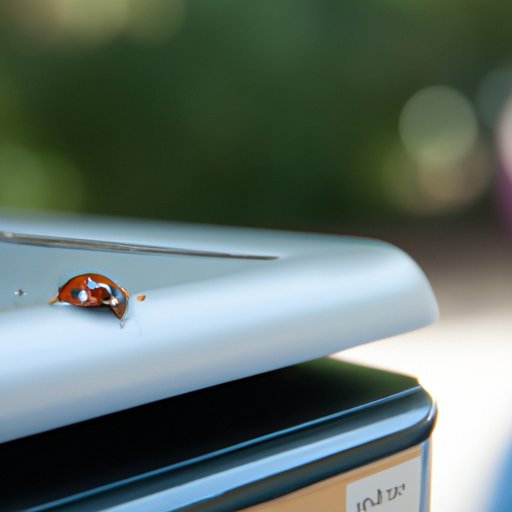
I. Introduction
Asian beetles, also known as ladybugs, are a common problem for households in many regions. Although they may look harmless and even cute, they can quickly become a nuisance and cause damage to both property and health. In this article, we will explore effective ways to get rid of Asian beetles, from natural repellents to professional treatments, as well as preventive measures to avoid future infestations.
II. Identifying the Problem
Before taking any measures, it is crucial to recognize the signs of Asian beetle infestation and understand their behavior. Asian beetles are small, oval-shaped insects that come in various colors, from yellow to orange to red. They are native to Asia but have spread to many parts of the world over the years. Asian beetles feed on plants and insects and are more active during the fall season when they search for a warm place to hibernate during the winter.
The common signs of Asian beetle infestation include a strong smell, especially in large numbers, a yellowish secretion on walls and other surfaces, and visible accumulation on windows, doors, and other light sources. They may also bite and cause skin irritation in some cases.
III. Natural Repellents
Natural repellents offer a safe and eco-friendly way to repel Asian beetles and other pests. Some of the most effective methods include planting herbs such as mint, chrysanthemums, and basil, which emit a strong odor that repels insects. Essential oils such as peppermint and lavender are also potent repellents and can be applied on windowsills, door frames, and other surfaces to deter Asian beetles. Another option is to use a natural pesticide made from diatomaceous earth, a powder-like substance that dehydrates and kills insects.
To apply these natural repellents, mix a few drops of essential oil with water and spray the solution on surfaces, or sprinkle diatomaceous earth in areas where Asian beetles are likely to gather, such as under windows and behind furniture.
The benefits of using natural repellents over chemical sprays include lower toxicity, no harm to the environment, and a more pleasant scent. However, they may require more frequent application and may not be as effective in severe infestations.
IV. Traps and Baits
Traps and baits are effective in reducing the population of Asian beetles and capturing them safely. Glue traps are a popular choice, as they are easy to use and can be placed anywhere Asian beetles are likely to gather, such as windowsills and corners. Light traps use ultraviolet light to attract beetles and trap them inside a container. Pheromone traps also use scents to lure beetles, making them more effective in larger infestations.
To use traps and baits, follow the instructions carefully and dispose of the captured beetles safely. However, there are also risks associated with certain types of traps and baits. Glue traps may harm other insects or animals that accidentally come into contact, and light traps can attract more beetles in some cases.
V. Professional Treatments
For severe or persistent infestations, professional extermination services offer a more comprehensive solution to tackle Asian beetles. These services use a variety of treatments, including chemical sprays, fumigation, and heat treatment, to eliminate the beetles and prevent their recurrence. Chemical sprays often contain pyrethroids or neonicotinoids, which are toxic to insects but safe for humans and pets if used according to the instructions.
To choose a trustworthy service provider, check their license, references, and experience in treating Asian beetle infestations. Also, ask about the costs, guarantees, and follow-up visits if necessary.
VI. Sealing Entry Points
Preventing Asian beetles from entering the household is also crucial in preventing infestations. Sealing any potential entry points, such as cracks, gaps, and openings in windows and doors, can greatly reduce the risk of Asian beetles and other pests. Use caulk or sealant to fill these openings and consider using weatherstripping or door sweeps to seal gaps around doors. Also, check other areas such as roof eaves, vents, and utility lines for any potential entry points.
VII. Good Hygiene Practices
To control and eliminate the attraction sources of Asian beetles, good hygiene practices are also essential. Vacuuming regularly and keeping food sealed can reduce the food sources of Asian beetles and prevent them from breeding. Avoid crushing Asian beetles, as they may release a foul odor that can attract other beetles.
VIII. Preventive Measures
To avoid future infestations, it is necessary to take preventive measures both inside and outside the household. Clear gutters and remove debris during the fall season, as Asian beetles can gather in piles of leaves and other organic matter. Keep the household clean and free of any potential habitats for Asian beetles, such as unused machinery or stored firewood. Monitor the household regularly for any signs of infestation and take action promptly if needed.
IX. Conclusion
Getting rid of Asian beetles requires a combination of natural and professional methods, as well as preventive measures to avoid future infestations. By following these tips and being vigilant about any signs of infestation, homeowners can effectively control and eliminate the Asian beetle problem and maintain a healthy and hygienic household environment.
Remember, acting quickly and efficiently is crucial in preventing Asian beetles from causing more damage and nuisance. Don’t hesitate to seek professional help if needed and take action as soon as you notice any signs of infestation.




